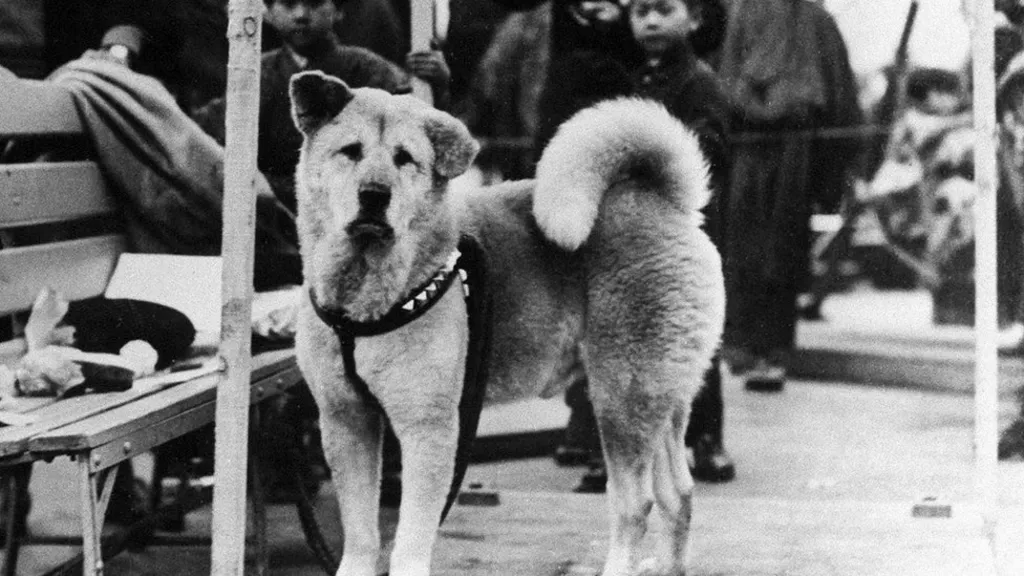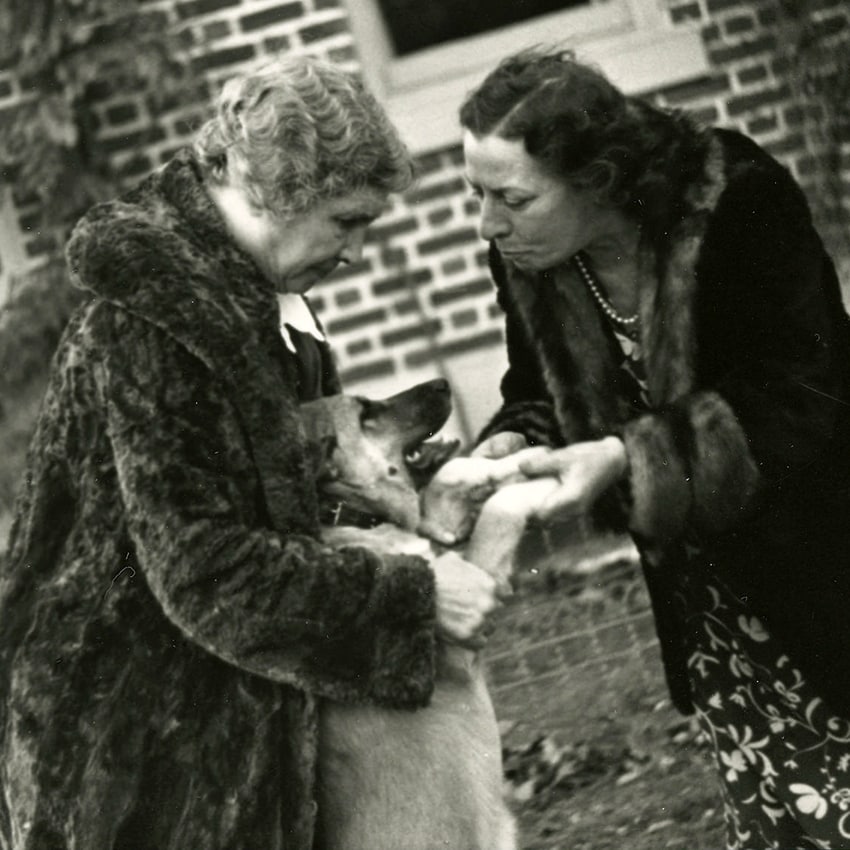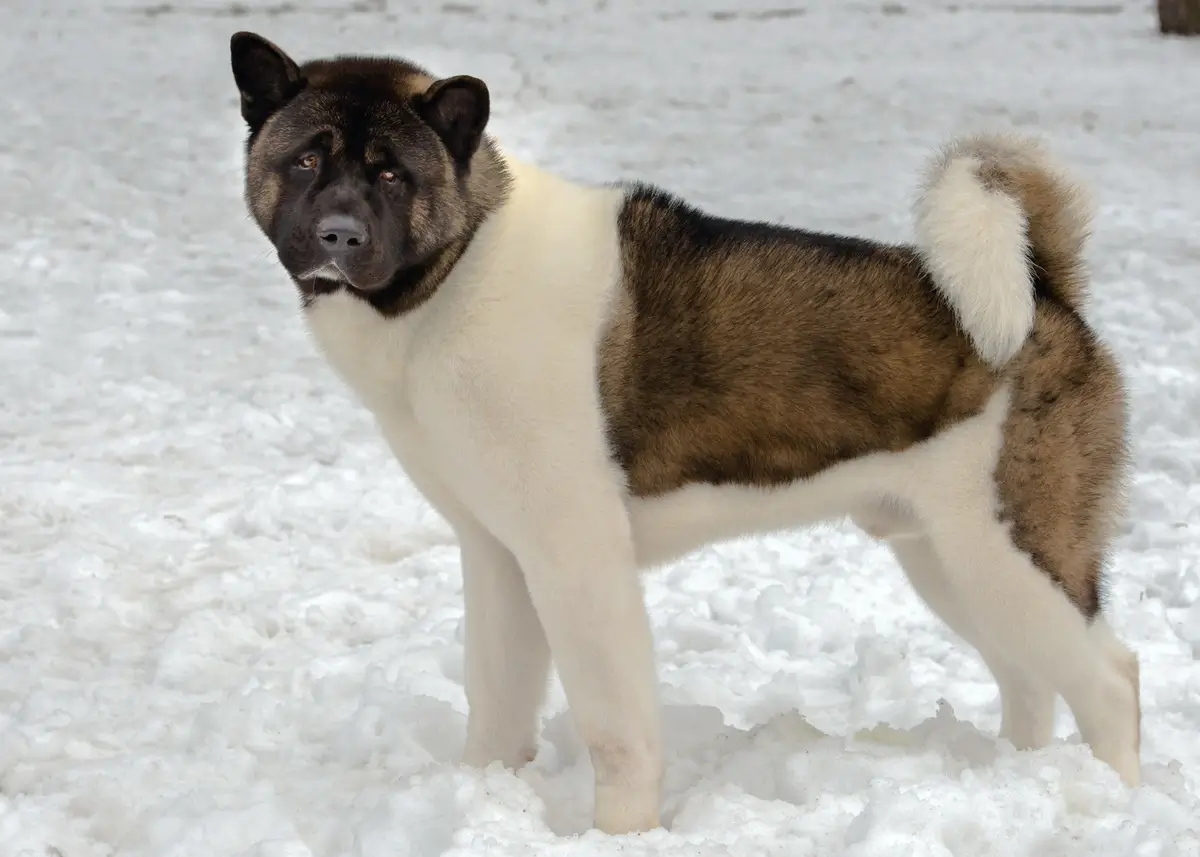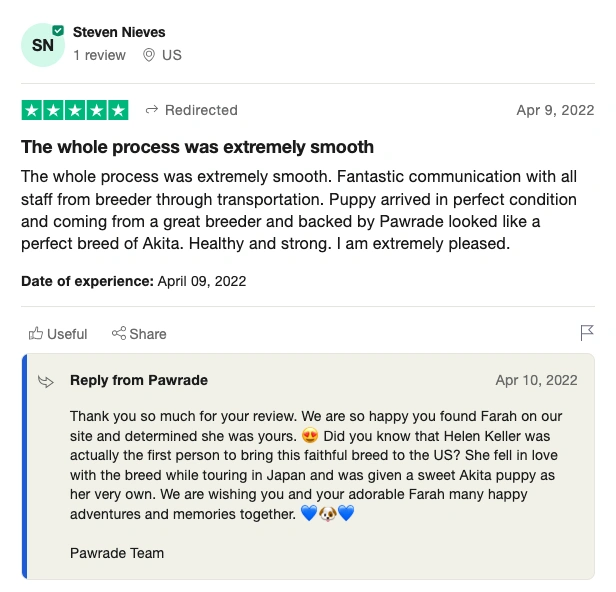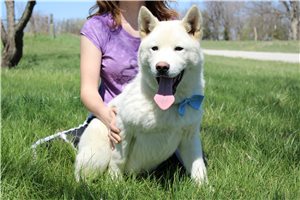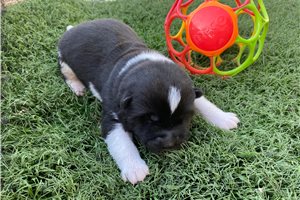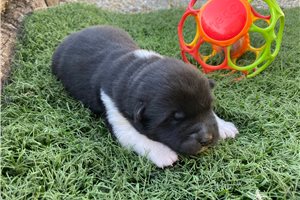Courage. Dignity. Loyalty. These are characteristics of one of Japan’s distinct dog breeds, the Akita.
This resilient guard dog has served as a symbol in Japanese culture for centuries, representing good fortune, prosperity, protection, and fidelity.
With a muscular build and gorgeous coat, an Akita is quite the regal canine. Proud and confident, Akita owners cherish these dogs for their devoted nature and independent spirit.
Akitas can be wonderful dogs to own with proper care and attention. However, it’s important to familiarize yourself with the Akita breed to see if their personalities are a good fit for your family.
Learn what it’s like to live with an Akita in our comprehensive Akita puppy ownership guide to see if this family protector is the right choice for you.
The History and Origin of Akita Puppies
The Akita dog breed has a rich history dating back to the 1600s in Japan’s mountainous Akita region, the northernmost province of the island of Honshu. It’s said the emperor banished a nobleman to Akita, who then developed powerful hunting dogs bred for endurance and strength to survive the rugged, cold climate of Honshu. Akitas were used for hunting large game like wild boar, bears, deer, and more. These dogs closely resembled Spitz dogs with fox-like eyes and small, triangular ears.
Over time, Akitas were trained to serve military purposes and as protection guard dogs of the Japanese imperial family and court, the only ones allowed to own Akitas. However, Akitas were bred for dog fighting and fell out of favor, their numbers dwindling to a dangerously low population.
Hachikō the Akita‘s heartbreaking loyalty
The story of Hachikō the Akita demonstrates an Akita’s unwavering love with his owner, Hidesaburō Ueno. Hachikō would come to Tokyo’s Shibuya Station to wait for Ueno to come home from his job as a professor. Sadly, Ueno passed away from a cerebral hemorrhage at work and never returned to the station and the waiting Hachikō. For nearly 10 years, Hachikō appeared at the station the exact time the train arrived. People began feeding him treats and keeping him company.
Hachikō became a national symbol of Japanese loyalty and faithfulness, impressing people with traits Japanese people held dear. His fame became a sensation and brought awareness back to the Akita breed, as there were only around 30 purebred Akitas at that time in the 1920s. Hachikō passed away from cancer, but he was treated well posthumously as he was in life. He was buried next to his beloved owner, and his body is still on display in a national museum today. A movie was even filmed to tell his story. Hachikō is a prime example of the Akita breed's bond and devotion toward their families.
Akitas come to America
Hachikō’s fellow Akitas went nearly extinct several times. However, they were still revered in Japanese culture as a symbol of unwavering loyalty and good fortune. Centuries-old traditions involving Akitas were still present, as it was customary for new parents to receive an Akita figurine to wish longevity and happiness for the new baby. A dedicated group of Akita lovers formed a Japanese national breed club in 1927 to keep the lineage strong.
Helen Keller received an Akita as a gift from Japan in 1937 named Kamikaze-Go (Kami for short), making it the first Akita on American soil. Soldiers returning from the Pacific in World War II introduced more Akitas.
American vs. Japanese Akitas: What’s the Difference?
Not everyone revered Akitas, especially during hard times. World War II brought food shortages, and people turned their Akitas loose when they couldn’t feed them. Another disturbing reason for the dwindling Akita numbers is the Japanese military wanted to use the Akita’s warm, insulating fur to line military uniforms. During one of the periods when Akitas nearly went extinct, great measures were taken to preserve them. Breeders had no choice but to breed Akitas with similar–looking dogs to keep the line going. Two distinct Akita lines became prevalent.
Named after a wealthy landowner, the Ichinoseki Akita line had origins crossed with Bulldogs, Mastiffs, and an imposing breed called the Tosa Inu. The Dewa Akita line crossed Akitas with German Shepherds. Akitas that came to America with returning GI troops were mainly of the Dewa line. Now called the American Akita, it is more bear-like, heavier, and stronger than the lean, tall, fox-like Japanese Akita.
Akitas today
The popularity of the Akitas gained traction in the 1950s as they once again became national treasures in Japan and loyal companions in the United States. They were accepted as a registered AKC breed in 1972, and the two types of Akitas continued to be seen as one, competing in the same category in dog shows. In 1999, the FCI voted to accept Japanese Akita Inu dogs as a stand-alone breed. Most Akitas you see in America today are of the Dewa line, and the highest concentration of Akitas in the world reside in the United States.
The Akita ranks #55 out of 199 breeds on the AKC’s Most Popular Dog Breed List of 2022 between Whippets and St. Bernards. Several famous people keep Akitas as companions thanks to their protective, loyal nature, including Drake, Sarah Michelle Gellar, Dan Aykroyd, Eric Christian Olsen, and Henry Cavill.
What Does an Akita Puppy Look Like?
Physically powerful and dominant, Akita puppies grow up to be large, imposing dogs. Adult Akitas will weigh 70-130+ pounds and stand 24-28 inches tall. Their massive, blocky heads rest on a muscular body. Their triangular-shaped ears stand on top of their heads, and their bushy tails curl over their backs.
Akitas have a thick, medium-length double coat built to withstand harsh elements. The AKC lists 20 colors and variations and 9 combinations of markings, a huge range offering a wide color choice for potential Akita owners.
Facts Akita Owners Want You to Know About the Breed
Akita puppy owners will tell you that Akitas are not for everyone. Understanding their quirks and behavior will help you raise a well-adjusted Akita puppy.
Loyal to a “T”
As you learned from Hachikō’s story, Akitas are unwaveringly loyal to their owners. They are hardwired to protect them at all costs and are always alert for anything amiss.
Clean and quiet
Akitas are fastidiously clean and do not like to stay dirty. They will even groom themselves sometimes like a cat. Not big barkers, Akitas rarely voice their opinion, unlike other cold-weather dogs such as a Siberian Husky.
Built for cold weather
Thanks to their mountainous origin, Akitas are a perfect cold-weather dog breed suited for frigid climates. Their thick, double coats help them stay insulated and warm even in sub-zero temperatures. Your Akita would thrive participating in winter activities like sledding, hiking, and more thanks to their dense fur and hearty stature. If you live in a hot climate, keep your Akita cool and in the shade during scorching heat. Never shave a double-coated dog because you will take away their ability to regulate their temperature.
Keep the lint roller handy
The magnificent, fluffy coat of an Akita can have a downside – they are medium-to-heavy shedders and will need regular brushing to keep their coats healthy. Akita owners will recommend you keep a lint roller in every room, your car, your handbag – you get the idea. Be sure to invest in a good vacuum cleaner meant for pet hair when living with an Akita.
Reserved yet silly
Akitas by nature are reserved dogs, wary of strangers and ready to protect their loved ones. They don’t warm up to unfamiliar people very easily. However, they are affectionate and silly with their owners when they feel safe.
Exercise needs
The exercise needs of Akitas are easy to meet for active individuals who enjoy staying on the move. An Akita will need around 30-45 minutes of brisk exercise and mental stimulation. Without enough exercise, an Akita can become bored and destructive.
Factors To Consider When Owning an Akita
While Akitas are regal and loyal, this dog breed has some special considerations if you wish to be an Akita puppy owner with their complex temperaments. Akitas are not great for first-time dog owners, as they need a firm hand from someone who understands the challenges of raising this breed. Like all breeds, researching the right dog breed for you is crucial to see if the characteristics of Akitas are the appropriate fit for you and your household.
Not a cuddle bug
Despite their fluffy fur and alert, keen expressions, Akitas are not going to be the dog breed that climbs up into your lap for cuddles. Even though they enjoy being in the company of their owners, they can be aloof and independent. Some even say they have a more primitive temperament than other dogs bred as companions.
Choosing a living space
Akita puppy owners should live in a household with enough space to accommodate a large dog, preferably with a secure, fenced-in yard. Overall, Akitas are not well-suited to living in close quarters like apartments. Some landlords and leases will not allow large dogs, let alone the Akita breed, so you’ll need to do your research to see if there are apartment breed restrictions for dogs that may affect where you choose to live.
Home environment
An Akita puppy will thrive in a household without young children and small pets. They do not get along well with dogs of the same sex and might not even get along with other dogs at all without proper socialization. Akitas have an extremely strong prey drive. Therefore, small pets like cats, gerbils, and more should not reside with an Akita. They will even go after deer with their fearless nature.
Potential health concerns
With proper care, Akitas can lead a fulfilling life of 10-14 years old. Taking them to regular wellness visits and establishing a relationship with a licensed veteran will prolong your Akita’s life. While a relatively healthy breed, potential health issues of Akitas can include hip and elbow dysplasia, hypothyroidism, and obesity. Make sure to feed them a quality diet.
Training and socializing your Akita
Because Akitas can quickly rule the household without proper training and thanks to their independence, you should start with a firm, consistent rewards-based training program from Day One. This breed will need ongoing training well beyond puppy kindergarten classes. You may want to employ a dog trainer or animal behavioralist to guide you in showing your Akita who is in control.
Socializing your Akita should also begin the first day your Akita arrives as a member of your household. Akitas should never be left to “figure it out” or wait and see if they naturally get along with other dogs. Akita puppies should be exposed to a variety of sights, sounds, and experiences to practice their socialization skills and reduce undesirable behaviors.
With a firm understanding of what it takes to create a well-rounded Akita, your puppy can become a great canine citizen if you put in the necessary work.
Where Can I Find an Akita Puppy?
When you are looking for an Akita puppy, you may not know where to turn. Because we’re so used to looking up everything in a search engine, you may look for “Akita puppies for sale near me” and be tempted to choose the lowest price you see. However, don’t fall for a trap. Learning to identify red flags in puppy scammers will help you determine where you adopt your Akita from.
Before buying the first Akita you find, ask yourself:
- Is the price too good to be true?
- Does the puppy come with a health guarantee?
- Do you know anything about the parents or early care?
- Do I know this puppy is actually a purebred Akita and not another breed?
- Will you receive proof of healthcare so far, like up-to-date vaccinations?
- Are you being asked to pay with an unsecure method like a MoneyGram or Zelle?
If you can answer “yes” to any of these questions, run! You have probably encountered a puppy scammer.
Pawrade offers Akita puppies from reputable breeders
Pawrade is a secure pet adoption service offering Akita puppies for sale from trustworthy Akita breeder partners who understand the breed and how to give Akita puppies the best start in life. Our breeders are only accepted into our program after passing rigorous standards.
We are proud to match potential Akita puppy owners with pre-screened Akita breeders. We work tirelessly to eliminate the risks associated with pet adoption scams. Our representatives actively monitor, intercept, and engage in all communication, whether via text, email, or phone, and participate in the process to ensure a secure and respectful exchange between you and your Akita breeder through a secure transaction management system, PetPay.
Our Akita puppies undergo comprehensive wellness exams and receive up-to-date vaccinations before leaving for your house. All Akitas are covered under a 3-year health guarantee that protects the buyer, the breeder, and most of all, the well-being of your Akita puppy. We also offer 30 days of MetLife insurance and several pet travel options to meet your Pawrade puppy.
Contact us today to begin your life with a loyal Akita puppy! We can’t wait to hear from you and help you through your Akita adoption journey.

